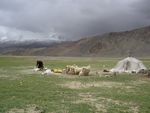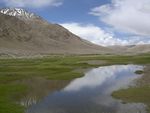PANORAMA - International Association of ...
←
→
Page content transcription
If your browser does not render page correctly, please read the page content below
Indian Regional Association for Landscape Ecology
PANORAMA
Ramesh Krishnamurthy
IRALE NEWS # 2 • MAY 2021
Landscape Vision This issue
RAMESH KRISHNAMURTHY | WILDLIFE INSTITUTE OF INDIA
Landscape Vision
Nature is an integrated system. Human, though being a tiny part of the PAGE 01
earth, tends to monopolize the natural resources. Even conservation
agendas largely remain utilitarian and have human welfare perspectives.
Therefore, there has been plethora of approaches to conserve nature
and to benefit societies across the globe. Though nature including Expert View on IRALE
human is multi-dimensional, the best approach still is area based, setting PAGE 02
aside designated areas for specific objectives. It has certainly offered
the framework and measurable targets to ensure the nature is preserved
for posterity. However, there is a definitive divide between designated
Protected Areas and other Natural Areas in terms of the perception and
therefore the importance. On the other hand, the dichotomy of ‘wildlife-
Landscape and Health
first policy’ and ‘people-first policy’ has placed conservation and human
development as opposing viewpoints. PAGE 03
Landscape vision offers conceptual models and framework to negate
contradictions towards a unified approach. Aptly, the India’s National
Wildlife Action Plan (2017-31) has brought in ‘Landscape Approach for
Conservation’. However, a clear operational strategy is needed. This
requires multidisciplinary inputs and implementation of working models. In Focus: Trans-Himalayas
In the short-term, spatially explicit National Landscapes Perspective Plan PAGE 04
(NLPP) would be required and in the long-term, the management
instruments need to synchronize under the natural resources to
implement actions on ground. Clearly, the solutions to everything
including the Pandemic that we are experiencing today will be nature-
based. However, our culture and lifestyle need to align to the realization
that much of the nature is exploited and that sustainable development
Members' Page
of nature and people is the only viable option. Indian Regional PAGE 06
Association for Landscape Ecology (IRALE) will work towards this
Landscape Vision and Integrated Development, which can integrate both
Nature and Culture-based solutions.
PANORAMA Page 01Ramesh Krishnamurthy How will IALE India shape Landscape Ecology? FELIX KIENAST PRESIDENT IALE INTERNATIONAL (2011-2015), SWITZERLAND Landscape ecology thrives on interdisciplinarity. This was Toll's vision back in the 1930s, and since then we have seen many new stimuli in landscape ecology that have moved the field forward. To name a few, "patterns and processes" played and still plays a prominent role in identifying corridors and barriers; new technologies like remote sensing help identifying all kinds of important landscape features; or the insight that landscapes are more than a collection of physical objects, which led to recognizing landscapes as social constructs. However, landscape ecology thrives not only on other disciplines, but also on the fact that the field is interpreted in fundamentally similar, yet regionally specific ways in various regions of the world. For example, landscape ecology in the United States is still strongly influenced by the patterns-and-processes paradigm, while in China a very strong urban ecology has developed. And what is the contribution of India in the family of IALE chapters? Will Indian landscape ecologists succeed in stimulating the field in a new and different way? It is to be hoped. When I, as the then President of IALE International, together with Dr. Ramesh Krishnamurthy, started to think and realize IALE India (IRALE), I did not have these disciplinary thoughts, because the formal establishment of the IALE Chapter was the primary goal and for this achievement, I sincerely thank Dr. Ramesh Krishnamurthy and his colleagues in India and also my successor, Christine Fürst, the President of IALE International from 2015-2019, who supported the idea of founding IALE India. Now all members of IRALE are challenged! You have to give your chapter a challenging profile. Will it be a very ecologically oriented landscape ecology - or one that focuses on technical achievements? Or something that is India-specific, that the rest of the world has never seen before? Time will tell! I look forward to reading much about your activities in your Bulletin (Newsletter) and wish you much success again. PANORAMA Page 02
Parabita Basu
Ramesh Krishnamurthy
Landscape and Health
PARABITA BASU | EKJUT
‘Health’ is described as a state of complete physical, mental and social
well-being (WHO 2017) and ‘public health’ emphasizes the health and
wellbeing of the whole populations. Access to natural environments play
an important role in public health, such as better handling of pollutions,
healthy lifestyle and mental health (WHO, 2016). Further, health
protection refers to preventing potential health risks and diseases and
health promotion refers to maintaining health, strengthening health
resources and safeguarding health-promoting environments. Due to
increasing urbanization and fragmentation of natural habitats, less
number of people could stay close to natural places (Sullivan & Chang,
2017). Hence, we need to understand how the landscapes we design and
inhabit impact our health and wellbeing. There is growing consensus for
health in planning, design and management of all landscapes. It is
important, therefore, to voice for the need of an interdisciplinary
cooperation between landscape planning and the health sector as the
healthy environment have larger impacts.
Role of landscape professionals has now become imperative to ensure
implementation of 'One Health Approach', which focuses on environment
health and public health as linked concept. We can carry this forward by
(a) working on strategies and policies with other professionals, agencies
"Over and over again
and other line departments, (b) valuing health and aesthetics into
masterplans and designs for any developmental activities, whether for
housing, schools, public realm or commercial projects, (c) leading we must stress that a
meaningful discussions with the ones' community and other
stakeholders using the participatory learning and action approach that healthy ecology is
reconcile the competing demands of stakeholders, resulting in informed
the basis for a
planning and design solutions, and (d) engaging in the restoration and
plantation activities or creative endeavors with the people suffering from healthy economy"
physical and mental illness in order to support the healing process and
provide an improved quality of life.
– Claudine Schneider
PANORAMA Page 03Amrita Neelakantan
In Focus: The Trans-Himalayas
AMRITA NEELAKANTAN | NETWORK FOR CONSERVING CENTRAL INDIA
Introduction: On the roof of the world, in the rain-shadow of the main
Himalayan range, lie barren mountains, cold deserts and arid areas
beyond the famous Nanda Devi and Kanchenjunga mountain ranges.
This is the Trans-Himalayas - an area spanning over ~1,84.823 sq. km
where myths are alive alongside astounding biodiversity.
Biodiversity: Biodiversity in the landscape is well suited to the arid
cold climes with many large mammals calling the Trans-Himalayas
home, notably, to the snow leopard and the kiang (wild ass) are
amongst the iconic species in the landscape. The Trans-Himalayas also
showcase natural geographic beauty that is unparalleled – some
calling it a moonscape for its rugged terrain. High-altitude wetlands
and lakes provide vital resource spaces for species that are endemic
to the region as well as those that migrate over the Himalayan
mountains (for more on the fauna of the Trans-Himalayas click here
and for patterns of distribution of flora click here). The Trans-
Himalayas include many national parks in India that serve as refuges
for elusive fauna and the last stands of wild flora (India’s national
parks list). Hemis National Park is globally recognized for the snow
leopard as well as mountain ungulates and lies in the heart of this
biogeographic region as the largest protected area in India. High-
altitude ungulates and domestic livestock provide food for the snow-
leopards and with many local communities, gompas (religious sites –
buddhist) including the 400 year old Hemis monastery still functioning
within it – Hemis reflects its past as an important node along the
Ramesh Krishnamurthy
ancient silk route.
PANORAMA Page 04Amrita Neelakantan
People: In the valleys forged by rivers such as the Shyok, Nubra, Indus
and Zanskar, live the agriculturists and nomadic herders. These lands
provide sustenance to the sparsely populated region with hardy
varieties of barley and increasingly modern agriculture allowing for
more bountiful food baskets. People began living in the region much
earlier than previously conceived. The earliest human occupation of
the Tibetan plateau (at nearly 4600 meters above sea level) was as 30
or even 40 thousand years back! The region was a gateway for trade
with central Asia along the silk route and continues to be the
stronghold of Buddhism. The stories of the Trans-Himalayas are filled
with demons and deities, dragons and animist spirits.
Nature-People Interface: With such a long history of people and
wildlife surviving in the harsh expanses of the Trans-Himalayas, the
region boasts of many enduring relationships between people and
wildlife that continue to foster co-existence. Conflict arises between
pastoralists and snow-leopards but conservationists have worked to
ensure that people’s needs are acknowledged in their attempts to
mitigate human-wildlife conflict losses. Innovative hides and sheds
form the basis of such mitigation strategies. Pastoralists’ herds also
compete with native ungulates for vital food stores. Finally, even on
the roof of the world, local communities and wildlife face the
marching in of invasive species – woody vegetation that is not from
the region, harms the agriculturalists as well as limits existing natural
habitats for wildlife. The Trans-Himalayas look daunting but the
influence of humans is ever increasing and presents many
opportunities for conservation to align with people as stewards of the
natural world.
Ramesh Krishnamurthy
PANORAMA Page 05Ramesh Krishnamurthy
1st Annual Symposium We look forward to the first annual symposium of IRALE, as
scheduled in the hybrid (physical/online) mode. As the Covid-
3-5 OCTOBER 2021 19 pandemic continues with devastating impacts across India,
SARISKA, RAJASTHAN
the situation will be re-assessed in July, with a possibility to
have the symposium in online mode.
Members' Page
You can register to become a member of Indian Regional Association for Landscape Ecology (IRALE) at
https://www.irale.org/registration.php and will then automatically become a member of the International
Association of Landscape Ecology (IALE) (https://landscape-ecology.org/). Being a member of IRALE, one
can avail the benefits/opportunities such as newsletters, access to landscape ecology journal, participation
Membership
in conferences, resource materials and updates on recent developments in the science and application of
landscape ecology.
Members can also join and lead Working Groups on various themes. These Working Groups are designed
to enable a platform for focused interaction and collaborations. IRALE member can join any of the
Working Groups while registering/renewing/updating the Membership. Although these are initially limited
to three preferences, one can contribute in other Working Groups too and also form a new Working
Group if required by contacting IRALE. Thematic champions and leaders are expected to be outcome of
these Working Groups. Small grants may be available to support Working Group activities.
Working Groups
PANORAMA
Editors: Ramesh Krishnamurthy, Vaishali Vasudeva and Amrita Neelakantan
Page 06You can also read


























































